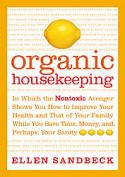Reviewed by Subha Ramanathan On a daily basis, it seems that every man, woman, and even child and baby is exposed to a range of toxic chemicals in our efforts to clean, moisturize and groom. While it has become common knowledge that there are potentially harmful pesticides in our foods, few are aware of the toxics that may be present in shampoo, face cream, makeup, deodorant and even toothpaste. Deacon focuses on the poorly regulated aspects of the body care industry, identifies the “Top Twenty Toxics,” and provides practical strategies to avoid them, which includes reading ingredient lists before making purchases and concocting your own body products using common items in your pantry.
Deacon discloses that she is a breast cancer survivor and her perspectives on body care toxics and her motive for writing There’s Lead in Your Lipstick relate to her health experiences. Although the direct causes of her tumour remain unknown, she suspects that exposure to dangerous toxics through body care played a role. Her three goals with this book are to raise awareness about greenwashing in product marketing (e.g., liberal/unsupported use of terms like “natural”, “organic,” “green” and “hypoallergenic”); to present information about common toxic ingredients; and to provide a guide for choosing products that are safer to put in, on and around our bodies.
The first chapter “Label reading 101” provides a brief summary of effects for each of the top twenty toxics, lists alternate names, and also the types of products that it is found in. For example, the final offender on the list (in alphabetical order) is triclosan, an antibacterial chemical found in soaps, lotions, and facial cleansers. Deacon explains that triclosan has been linked to endocrine disruption in lab studies and environmental harm, though specific details and scientific references are not included (see EWG's Skin Deep for more information). This chapter also explains that there isn’t strong scientific evidence to ban the toxics in the amounts that they are present in any one product. However, the total “chemical body burden” that comes from using multiple products over time likely causes the greatest harm. Furthermore, the combination and cumulative effects of body products may even affect gene expression and be passed down from generation to generation. Deacon writes, “almost certainly, the untold combinations of chemicals building up in our bloodstream and organs, based on generations of synthetic exposure, have an impact on our bodies’ ability to function in top form” (p.19-20). She also raises the issue that research, development, and market release of new body care products happens so quickly that Health Canada and other regulating bodies could not possibly study their long-term impacts on humans or our environments.
So what are we to do??? Until policies and regulations catch up, unfortunately the onus is on us to be our own advocates, educate ourselves, and choose our products wisely. Deacon’s chapters are divided by major body parts (hair, face, eyes, lips, etc.) with reviews of products free of the toxic offenders, information on where to buy them, and average retail costs. Whenever available, online retailers and Canadian manufacturers (e.g., Green Beaver and The Soap Works) are featured, making the product suggestions accessible to those that live in rural areas and helpful for people who endeavour to buy local. There are recipes in each chapter, some on the more complicated side, and some simple homemade solutions, like an apple cider vinegar and water rinse for dandruff control. In essence, Deacon sounds the alarm on toxic body care, but empowers us with easy to understand information and plenty of options for minimizing our exposure.
Overall, a drawback of Deacon’s book is the lack of reference to research supporting the selection of the top twenty toxics and some of the claims made about harm. For example, how was the “Top Twenty” list compiled? What made the cut and what did not? Some offenders, like lead and formaldehyde, are backed by a series of longitudinal studies showing adverse impacts (though none of these are cited). Others, like polyethylene glycol (PEG) aren’t necessarily toxic on their own, but may be contaminated by carcinogens like 1,4-dioxane. It would be helpful to know when contamination is most likely, and the level of harm, maybe on a Health Hazard Scale like that used by the Environmental Working Group (www.ewg.org). Also missing is a discussion of how much is absorbed and some indication of priority on what to avoid. Is it worse to have toxics in body lotion because of the large area of application, or is it worse in toothpaste because it goes directly into our mouth? If beyond the scope of the book, an appendix with references and links specific to each toxic would suffice for people (like me) who want to weigh the best available evidence to draw my own conclusions.
As a final note, it would be helpful to know what to do with your old products when you purchase alternatives. This summer, I switched to a vegetable glycerine bar of soap and stopped using body washes with parabens, sodium lauryl sulphate and artificial fragrance. But what do I do with my half-used and brand new bottles? It’s probably not a good idea to dump them into the toilet, and doesn’t feel right to gift them to a friend or donate to a shelter. If anyone has any ideas, please let me know.
A Few Notes from the WHEN Office: Definitely don't dump them in the toilet! Try taking your partially used, toxic filled products to your local community's "environment day(s)". If they are collecting old paint, and other hazards they usually will accept and properly dispose of these products, just as they would other household hazardous waste.
The word "toxin" in the original review was changed to "toxic" during editing to acknowledge that the definition of toxin is of a poison created inside a living organism. WHEN refers to industrially manufactured toxicants as toxics instead.








